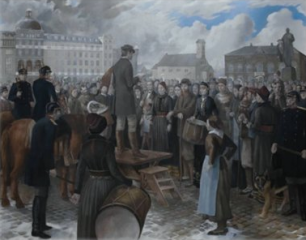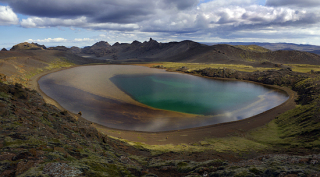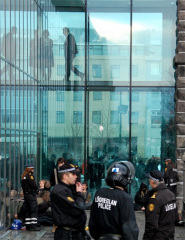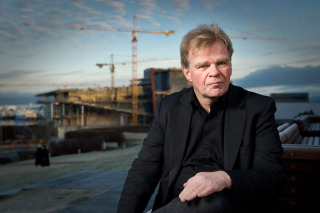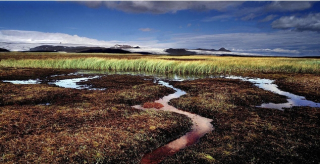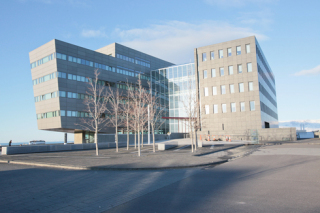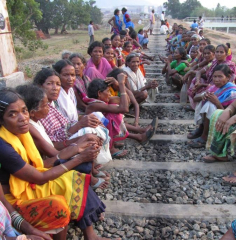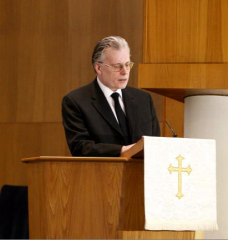Articles
Oct 07 2011
Democracy deficit, Economic Collapse, Media bias, Neo-Liberalism, Saving Iceland
Árni Daníel Júlíusson
It is funny how things can turn around. For decades, Iceland languished in neoliberal hell, with signs of opposition few and far between. Meanwhile the opposition to the neoliberal order of things grew all over the world—with massive protests in Seattle, Genoa and elsewhere—and the beginnings of a world-wide anti-globalisation movement represented by the World Social Forum, first held in Porto Alegre, Brazil, in 2001. Almost nobody in Iceland did or said anything to support these powerful movements against the neoliberal order, with the exception of the brave Saving Iceland organisation. Read More
Sep 11 2011
ALCOA, Alterra Power/Magma Energy, Century Aluminum, Ecology, Economic Collapse, Energy Master Plan, Helguvík, Hengill, Kárahnjúkar, Krafla and Þeistareykir, Krýsuvík, Landsvirkjun, Reykjavik Energy, Rio Tinto Alcan, Sigmundur Einarsson, Þjórsá, Þjórsárver
The equivalent of three Kárahnjúkar dams will be built in Iceland in the near future if the parliament will pass a proposition for a parliamentary resolution on Iceland’s Energy Master Plan, which the Ministers of Environment and of Industry presented three weeks ago. Despite this, Iceland’s energy companies and parliament members in favour of heavy industry have already started complaining – arguing that way too big proportion of Iceland’s nature will be declared protected, will the proposition pass. Among the power plants allowed for in the proposition are three dams in lower Þjórsá, which for years have been a topic of heavy debate and in fact completely split the local community and are more than likely to become the bone of contention between the two governmental parties as the Left Greens (VG) have, along with other environmentalists, voiced their opposition to the damming of Þjórsá.
The Energy Master Plan is a framework programme, meant to result in a long term agreement upon the exploitation and protection of Iceland’s glacial rivers and geothermal areas. Its making, which since 1999 has been in the hands of special steering committiees, established by the two above-mentioned ministries, reached a critical status in July this year when its second phase was finished and presented to the ministers who in mid August presented their proposition for a parliamentary resolution. Before it will be discussed in parliament the proposition will be open to comments and criticism from the public, as well as interested parties, energy and aluminium companies on the one hand, environmentalists on the other. Read More
Sep 09 2011
1 Comment
Actions, Laws, Repression, Saving Iceland
By Snorri Páll Jónsson Úlfhildarson
On Friday September 2, two men appeared in court in downtown Reykjavík. It wasn’t their first time—and it probably won’t be their last. If found guilty, the defendants, Haukur Hilmarsson and Jason Thomas Slade, face up to six years in prison, due to a peculiar action on their behalves that marks a turning point in Icelandic asylum-seeker affairs.
On the morning of July 3, 2008, Haukur and Jason darted onto the runway of Leifur Eiríksson International Airport in Keflavík, hoping to prevent a flight from departing, and deporting. Inside the plane, which was headed to Italy, sat one Paul Ramses, a Kenyan refugee. The two activists ran alongside the plane, and placed themselves in front of it—halting its takeoff.
It would be wrong to assume that anything has changed since 2008. Iceland may have seen an infamous economic collapse followed by a popular uprising and a new government, but for the two activists it must feel like time is standing still. Since their arrest at the airport, they have been stuck in a seemingly endless legal limbo, first charged for housebreaking and reckless endangerment and later thrown between all levels of the juridical system. Last Friday, the case’s principal proceedings took place for the second time in Reykjavík’s District Court, after the courts original sentences were ruled null and void by Iceland’s Supreme Court. Read More
Aug 27 2011
Cultural, Democracy deficit, Economic Collapse, IMF, SIC Report
The following chapter is from ‘Bankastræti Núll’, the latest book by poet and author Einar Már Guðmundsson, translated and originally published in The Reykjavík Grapevine, parallel to an introduction to Einar by Alda Kravec. The introduction says that the book “opens with the narrator’s lament: the current political situation has stifled his ability to write poems to his lover. Although he foresees a future where “reality wakes up” and poets can once again sing the praises of love and nature, the resounding sound of social injustice presently overwhelms him and beckons him to first engage in the struggle against the free reign of the stock exchange, privatisation and greed.”
It is written somewhere that all cats are grey in the dark, but here in Iceland, official reports are all black, no matter how bright it is outside. Alþingi’s Investigative Commission’s Report is black. The Central Bank’s Report on the status of household debt is black. And the government and International Monetary Fund’s Memorandum of Economic and Financial Policies is also black, dark as a coal mine, and sure enough, it was drafted in April, the cruellest month. It is a reminder of the misery that the IMF has presided over in countries all over the world, and directly refutes the notion that the IMF plans to apply different methods than those it has adhered to until now.
In Greece, the public has risen up against the Fund’s plans, but here the labour movement and employers get into bed with it and are almost more devout than the Pope in getting investors to come here with their baggage of offshore profits and dummy corporations. In one district, where neo-liberals have sold everything and there is nothing left to mortgage except the harbour, efforts are being made to set a precedent by selling natural resources through a shelf company just so politicians can save face after having handed over the entire district to their associates and relatives on a silver platter. Read More
Jul 29 2011
2 Comments
Corruption, Repression, Saving Iceland
By Snorri Páll Jónsson Úlfhildarson. Originally published in the Reykjavík Grapevine.
In a very short time the discourse following last week’s right-wing terrorist attacks in Norway reached both absurd and scary heights, with one of the best examples being American TV and radio host Glenn Beck’s attempt to justify the mass murderer by comparing the social democratic youth camp on Utøya with the Hitler Youth. In Iceland it was the writings of Björn Bjarnason, a right-wing conservative and Iceland’s Minister of Justice from 2003 to 2009.
Only a day after the attacks, Björn, who systematically voiced what he called “the need” for the establishment of an army-like police force when he was Minister of Justice, wrote on his website – one of Iceland’s oldest blog-sites, frequently quoted by journalists – that the Norwegian state, with its powerful secret police force, should have all the necessary tools to fight the threat of terrorism. According to Björn, this police force keeps a strict eye on potential terrorist cells – groups that operate “in service of political ideals” or “under the banner of environmentalism or nature conservation.” Read More
Jul 23 2011
Century Aluminum, Democracy deficit, Ecology, Economic Collapse, Energy Master Plan, Guðmundur Páll Ólafsson, Hengill, Kerlingafjöll, Krafla and Þeistareykir, Landsvirkjun, Reykjanes, Rio Tinto Alcan, Torfajökull, Tungnaá, Þjórsá
The making of Iceland’s Energy Master Plan, a framework programme concerning the exploitation and protection of the country’s natural resources, which has been in the making since 1999, has reached a critical state as a report on the process’ second phase was published in the beginning of July. The report includes a list of more than 60 areas, arranged from the perspectives of both protection and exploitation, which is supposed to lay the foundation for a final parliamentary resolution concerning the Master Plan. While those in favour of further exploitation, parallel to the continuous build-up of heavy industry, seem generally happy with the report, environmentalists are both sceptical and critical, stating that the exploitation value was always in the forefront of the process.
Like explained on the project’s official website the process was “split into two phases. The first phase, 1999–2003, evaluated and ranked 20 large-scale hydro-power options, mostly located in the highlands, and the same number of geothermal options in 8 high-temperature areas.” The second phase was supposed to “rank all the options to produce the final result,” including “an evaluation of whether some areas should be conserved completely, without any energy-harnessing activities.” Proposed power projects were said to be “evaluated and categorised on the basis of efficiency, economic profitability, and how they will benefit the economy as a whole,” while the “the impact on the environment, nature, and wildlife” was also supposed to be evaluated, “as well as the impact on the landscape, cultural heritage and ancient monuments, grazing and other traditional land use, outdoor activities fishing, and hunting.” Read More
Jul 16 2011
1 Comment
Century Aluminum, Corruption, Economic Collapse, Economics, Greenwash, H.S. Orka, Hengill, Reykjavik Energy
By Anna Andersen, photos by Alísa Kalyanova. Originally published in The Reykjavík Grapevine.
Overrun by Viking ambition, Reykjavík Energy built headquarters fit for Darth Vader, expanded ambitiously, dabbled in tiger prawn farming and flax seed production, went into the fibre optics business, invested in a new geothermal plant, speculated in places like Djibouti, and finally managed to run itself so completely into the ground that foreign investors will no longer offer the company loans.
In hopes of rescuing its multi-utility service company from the depths of abyss, the city of Reykjavík stepped in this March with a 12 billion ISK (105 million USD) loan, which is nearly its entire reserve fund set aside for the company, but still only a fraction of the company’s massive foreign debt of 200 billion ISK (1.7 billion USD).
With thousands of captive lifetime subscribers and a means of producing energy at very little cost, the company had all the makings of a cash cow. So what happened to Reykjavík Energy, an entity that less than a decade ago was a perfectly viable, municipally owned company providing the city with basic utilities: cold water, hot water and electricity? Read More
Jun 23 2011
1 Comment
Corruption, Democracy deficit, Economic Collapse, Laws, Repression, RVK9, SIC Report
By Snorri Páll Jónsson Úlfhildarson
Originally published in The Reykjavík Grapevine
A little more than a year ago, several Icelandic bankers were arrested and kept in custody in relation to the Special Prosecutor’s investigation into the 2008 economic collapse, its antecedents and causes. Appearing in political TV talk show Silfur Egils shortly afterwards, French-Norwegian magistrate Eva Joly, who at that time served as the Prosecutor’s special assistant, talked about how society does not expect—and has problems to deal with—politically and economically powerful people being arrested, interrogated and possibly sentenced.
Eva Joly was right. And the reason? Habit. Whether a journalist, police officer, lawyer, judge or a powerless citizen, in a civilised society based on dualistic ideas of good and evil, one is most likely unable to recognise well-dressed and eloquent people—with possessions and power in their pockets—as anything other than good. During the interview, Eva compared those people with drug users and dealers that are brought to court, who generally are immediately seen by society as criminals deserving to face “justice”. Another rightful comparison would be political dissidents. Read More
May 24 2011
5 Comments
Bauxite, Corruption, India, Mining, Miriam Rose, Orissa, Pollution, Red Mud, Repression, Samarendra Das, Vedanta
From Miriam Rose
On 16th May after heavy rain, toxic red mud poured from a breach in one of Vedanta’s Lanjigarh refinery red mud ponds, spilling onto the village below. The next day landless people displaced by the project held two blockades demanding adequate compensation; a five day walking protest ended with a meeting of 500 people on the threatened Niyamgiri hills; and the funeral of a tribal movement leader, killed by factory pollution, was held. Two months before Vedanta’s often-subverted AGM this will be bad news for the company. This is a direct report from the scene. Read More
May 20 2011
5 Comments
Corruption, Democracy deficit, Laws, Mark Kennedy, Media bias, Ólafur Páll Sigurdsson, Repression, Saving Iceland
Statement from Saving Iceland regarding the recently published report by the National Commissioner’s ‘National Security Unit’. The report was requested by the Minister of the Interior and was supposed to answer the questions if the Icelandic police were aware of and collaborated in British police spy Mark Kennedy’s infiltration of the Saving Iceland network. (Translated from Icelandic.)
The Saving Iceland network has spent some time examining the report authored by the National Commissioner’s ‘National Security Unit’ published on May 17. Already at this stage we would like to make a considerable number of remarks.
First of all we have to express our astonishment if Ögmundur Jónasson, the Minister of the Interior is going to accept as valid the poorly reasoned cover-ups that are resorted to by the report’s authors. It is also remarkable how superficial and simply untrue the Minister’s own interpretation of the report has been so far. Unfortunately the same is true of the coverage of the report made by some of the Icelandic corporate media.
The report’s most serious flaw is of course the fact that it completely evades the responsibility that it was officially intended to assume. The only de facto information about the report’s actual subject is on page 12, where it is stated that the police received “confidential information” concerning the intended protests against the Kárahnjúkar dam from both domestic and foreign “informers”, and that this information was used to organize the police’s reaction. Read More
